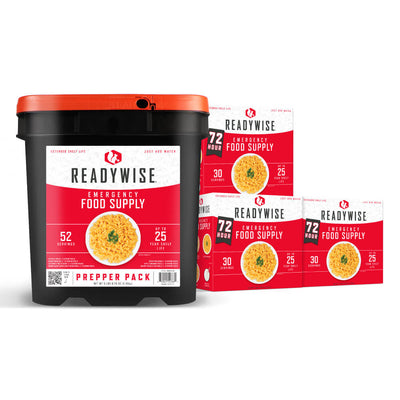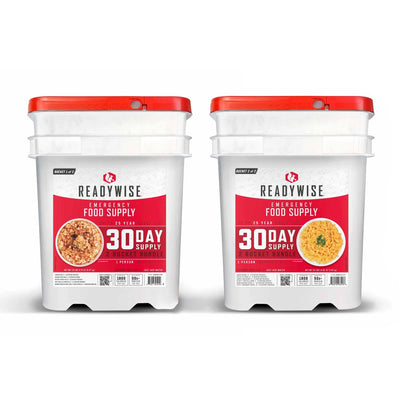Preparedness Tips for Natural Disasters
With the creature comforts that surround many of us, it’s hard to imagine how quickly it all could change. But all you have to do is turn on the news, or ask any disaster survivor, to know that when a natural disaster strikes, your life can be turned upside-down in a matter of hours, minutes or even seconds.
Preventing natural disasters isn’t an option—so, the only alternative is to be prepared for them. No preparedness list will be comprehensive, and you’ll always need to adjust your preparations depending on where you live, what types of disasters are most likely to strike and your family’s unique needs. There are seven tips that can get you started now on making sure your family is well-prepared when the unthinkable happens.
Have three days’ worth of a supply of food and water ready for everyone in your household.
A trip to an empty-shelved grocery store before a hurricane will remind you of the extreme importance of having food and drinking water supplies at the ready. Government disaster preparedness experts recommend the following:
- A supply of non-perishable foods that don’t require cooking or extensive preparation, such as protein bars, dried fruit, canned food, peanut butter, canned juice and food for infants and children.
- One gallon of water per person, per day, for at least three days. Buy commercially bottled water if possible, or store tap water in food-grade containers. Keep in mind that kids, nursing mothers and elderly people will often need more water.
Create an emergency survival kit or “go bag.”
Disaster preparedness professionals sometimes differ on exactly what should go in your survival kit, but there are a few things that basically everyone agrees are necessary.
- First aid kit
- Flashlights with extra batteries
- Battery-powered or hand crank radio
- Personal hygiene supplies such as toilet paper, dental care products, tampons and pads and deodorant
- Airborne contaminant protections like plastic sheeting, duct tape and dust masks
- Supplies of any prescription medications that family members take (make sure to note the expiration dates)
- Insulated clothing (if you live in a cold climate), including warm and durable headwear and insulated gloves.
Keep your disaster supplies where they’re easy to access in an emergency, and don’t forget to check them periodically to make sure nothing has gone missing or to change out items with expiration dates. If your area has seasonal disaster risk, such as hurricanes in the fall or fires in the summer, right before the start of your disaster season is the perfect time to check your kit and make sure that it’s ready to go.
Prepare your pets.
If you’ve got four-legged family members, don’t forget to make sure they’re just as disaster-ready as your human family! Make sure that all pets are microchipped and have collars in case they get lost, get their carriers ready and set aside food and water supplies for them as well. You can also get free stickers from the ASPCA to alert rescuers that pets may be inside your home and in need of rescue. It’s also important to note that if you have to evacuate, many hotels don’t allow pets—so make sure you have a plan of where you can go that your furry friends will be welcome.
Make and store copies of your most important documents.
You don’t want to be stuck recovering from a disaster without your essential documents. You should have both digital and physical copies of all of the following:
- Deed to your home
- Insurance policies
- Proof of ID such as passports and Social Security cards
- Medical records
Store your digital copies in one of the many cloud-based document storage services, and put the physical copies in freezer bags to keep them safe from water damage.
Know how to shut off your utilities if you need to.
Electricity, water and gas that are left on during a disaster can make your problems worse. FEMA recommends that every adult in the family should know how to turn off gas mains, water mains and the power supply. You can buy special tools to perform some of these tasks, but wrenches and pliers will also often serve in a pinch. This is a step you should take if you’re evacuating or if government authorities tell you to.
Take steps to protect your home if evacuation is ordered.
It’s always hard to leave your home and possessions behind, but sometimes it’s necessary for everyone’s safety. If local authorities have ordered an evacuation, the following steps will help protect your home as best you can in your absence:
- If you don’t already have storm shutters installed, nail plywood over your windows to protect them.
- Bring things inside from your yard, such as birdhouses, kids’ toys and other items that can be tossed around and cause damage to your home during a storm.
- If you have an upper story, use it to store valuables and furniture that you can’t take with you.
- Lock all windows and doors to keep out anyone who may be looking for houses to loot after the disaster.
Keep the information flowing.
In a natural disaster, it’s critical that you stay informed on the conditions around you. Use your radio (or the internet, if you still have access to it) to stay informed on whether evacuations have been ordered, as well as weather conditions outside. The view from your window may not always show you an accurate picture of the actual conditions, so, when in doubt, trust the official announcements.
Finally, some advice that should be obvious—if your area is under an evacuation order, don’t put yourself or your family in danger by staying put. Refusing to evacuate poses all kinds of dangers, and it’s even possible to get fined by the government for it. No matter how prepared you are, it may not be enough if your area is without emergency services for days or weeks.
Natural disasters are among the scariest things on Earth. They remind us how small and fragile we are as humans. But the other great thing about humans is that we’re resilient, resourceful and smart—and good disaster preparedness can help you be at your best, even when conditions are at their worst.
Author Bio: Natalie Bucsko serves as the Marketing Communications Specialist for RefrigiWear. From the Dahlonega, GA headquarters, Natalie oversees all content, including the website, knowledge center, blog, catalog, email, and social media. Before joining RefrigiWear, Natalie worked as a Marketing Coordinator for several years at companies ranging from startups to insurance. She enjoys cooking and baking, sports, reading and spending time outdoors – especially when it is cold!
















































































